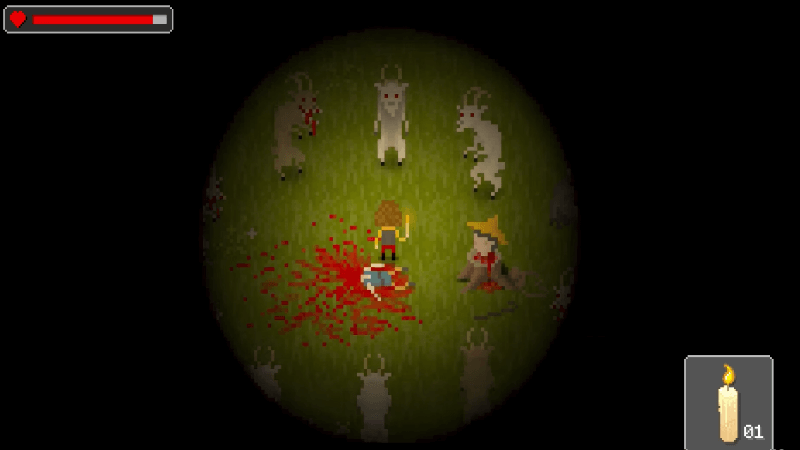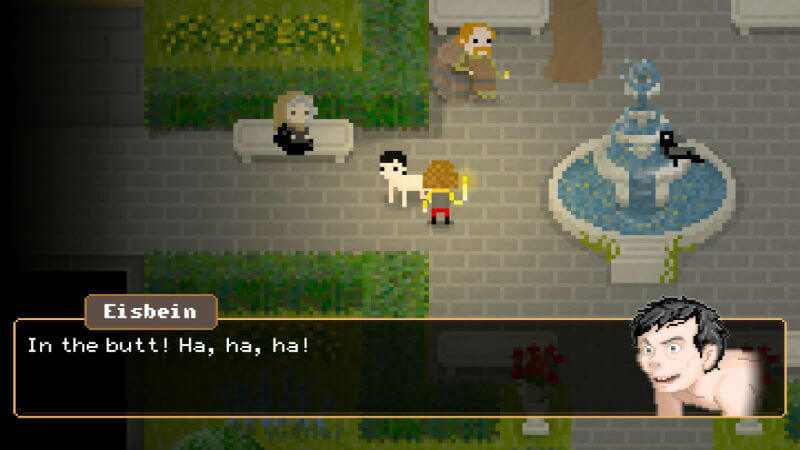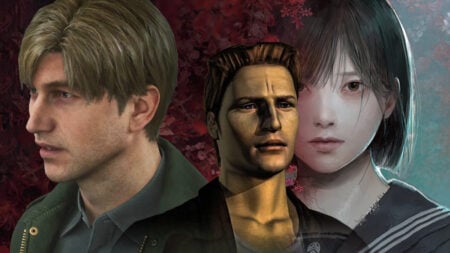Title: The Count Lucanor
Available On: PC, Mac, Linux
Publisher: Baroque Decay
Developer: Baroque Decay
Genre: Adventure, Horror, Mystery
Official Site: The Count Lucanor
Release Date: March 3, 2016
Where To Buy It: Steam ($9.99)
The Count Lucanor is the first game – both published and devolved – released by Baroque Decay Studios and is an adventure game that follows Hans, a poor 10-year-old boy who sets out with the hopes of finding wealth. The studio relays that the Pixel adventure was inspired by classics like Zelda and Silent Hill and after playing through The Count Lucanor multiple times -averaging around 3 hrs each time dependent on different endings- those influences were certainly on display.
While the game starts out in a small cottage with Hans and his mother celebrating his birthday, the adventure slowly grows into an eeire experience. Upset at being so poor that his mother couldn’t afford to get him any gifts, Hans sets out on his own to his mother’s dismay. After a few interactions with some eccentric folk, Hans awakens to a dark disturbing world, surrounded by terrors, eventually following a strange blue kobold to a castle.
At the castle, the creature reveals the estate belongs to the Count of Lucanor and that anyone who could complete his trials would be rewarded with extreme wealth. The trial begins by simply figuring out the blue kobold’s name, with letters strewn about the different rooms (like dungeons) in the castle. This portion of the trial takes up a vast majority of the game and did a fine job of teaching me how to play the game without holding my hand with obvious tutorials.

The puzzles for each room aren’t necessarily groundbreaking – usually being made up of fire traps, spikes and other notably cliche adventure game traps – but are intricate enough without being lazy. While I can admit I’m not the best at puzzle games, the puzzles in The Count Lucanor managed to feel puzzling without being insulting. Each room has either a specific puzzle or a specific unique layout, never repeating previous puzzles for the sake of prolonging the experience. As the game progresses, the bell chimes three and the servants are introduced, adding a level of challenge to traversing the rooms and the hallways connecting them.
Once those enemies were introduced, part of me thought I would now be given a weapon in order to fight. Instead, it became a game of chess, strategically placing candles down in order to not be snuck up on by enemies, giving Hans time to hid under desks or behind curtains. It’s a concept that I’ve seen in games before – hide, don’t fight – but it makes a lot of sense in The Count Lucanor. Not only is Hans a 10-year-old boy, but the servants and the Red Camerlengo are terrifying creatures that even the noblest of knights could not defeat. The realization that I needed to hide from these creatures instead of being able to fight them added dread to the game’s ambiance.
One of the most distinct and commendable features in The Count Lucanor is it saves system. Instead of just having a spot that I could save at any point, there were only two specific locations in the game in which saving was possible, but not guaranteed. In order to save Han’s soul (aka saving) a sacrifice of one gold coin was required to be tossed into the crows fountain to create a save slot. While gold coins are attainable in multiple places throughout the map, they aren’t infinite, adding a layer of decision making and inventory management into a (usually) otherwise trivial aspect of most games. But the game is kind enough to make an individual save slot for each coin spent, so if you are dumb like me and accidentally saved twice in a row or just want to go back to a previous save, you can (and quick too, with swift load times).

Though The Count Lucanor may be a simple 8-bit pixel game, Baroque Decays attention to detail in regards to both graphics and sound design is top notch. Instead of warning you that spikes come from this wall with a fourth wall breaking sign near a trap, the game covers certain areas of the ground with blood to indicate the splatter from previous victims of the trap, indicating which spots to avoid. While not as important a detail as the blood splatter, I enjoyed how dark rooms scattered with fire traps would vary illumination wise depending on which fire traps were currently lit. While all this adds to the aforementioned spooky ambiance of the game, the sound design is what makes everything genuinely unnerving. Footsteps and whispers both reveal the Count’s servants are nearby and make me contemplate putting the game down for a second every time I heard them.
Like most horror games, I eventually got used to their presence and became able to outsmart the enemies. A combination of patience and avoiding hit boxes eventually gave me the courage to get by these scary individuals. But even knowing them as well as I did, they would still get the better of me from time to time regardless of my efforts as a result of their frustrating paths. While having enemies on strict, fixed paths would have been a little mundane, the alternative was just as annoying. The servant’s patrols were the definition of random, pacing back and fourth for random incriminates of time in front of whatever door I needed to access until they wondered off.

While the game revolves heavily around the trials and navigating the monsters that protect each task, I can’t say enough about the world that Baroque Decay built. Though the plot isn’t unprecedented (even with multiple endings) the character and their dialogue are fantastic. From a headless Goatherder – killed by the demon goats he herded and subsequently becoming herded by those goats himself – to a smart ass man turned into a pig by his witch mother, the characters all manage to be funny and clever, while simultaneously fitting into the grim circumstances of the game’s plot.
Honestly, I can’t recommend this game enough. Simple, yet enjoyable mechanics, fun puzzles, replayability and a majestically weird lore and the world to explore make The Count Lucanor a must buy for anyone that has the ability to pick it up. And for the price of $9.99 – and Steams reputation for putting things on sale quicker than a hiccup – it’s a hell of a bang for your buck. Be sure to look out for the studio’s next game, Yuppie Psycho, as it releases this year.
- Gameplay: An enjoyable amount of puzzle solving that manages to avoid repetition
- Graphics: A nice mesh of 8 and 16-bit style, with a great attention to detail
- Sound: Eerie and unnerving
- Presentation: Perfect pacing, with plenty of replayability
[embedyt] https://www.youtube.com/watch?v=5Nb_-cbNbw4[/embedyt]
[review]







